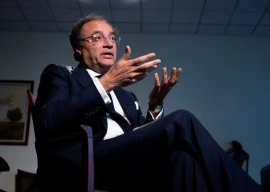
The story of Pakistan is overwhelmingly male. Whether we discuss politics, economics, history, literature or entertainment, we tell the stories of men and we tell them with a dominant male perspective. Take Independence Day celebrations in the media, for instance. There are stories of our soldiers’ valour, fighter pilots are glamourised, farmers are shown driving a tractor tilling the land, male welders are working on construction sites and boys are shown playing cricket in the grounds of Minar-e-Pakistan. If we are lucky, there are a couple of mentions of women. Usually, maternal women are shown praying for the country and its soldiers, elderly chador clad virtuous women are shown in caregiving roles or perhaps, shown as a teacher or nurse. The rest are not given any representation.
If such a representation is to be believed, then a very small percentage of our population is female and this is the country of men. The concept of char deewari and women staying inside is a very urban middle class notion and a considerably small percentage of our population falls under this category. The fact that our national narrative is designed such that it has no place for women who do not cement this patriarchal notion — that only a woman who is covered in a chador is virtuous and worthy of respect — is mindboggling. A visit to any village in most parts of the country would discredit this notion. Women work in their homes, outside their homes, they work long hours in barns and on farms and contribute significantly to the economy. Their contributions may not formally be acknowledged in the GDP but their productivity is part of the society and economy.
The popular model of women that gets space in the national narrative is not only misogynist — showing women in supporting roles only, as if they are not capable of living a full life — but is also very classist. Most women cannot afford to stay at home and thus must work — at times, harder and for longer hours than men, in order to make ends meet. If the chador clad stay-at-home woman is peddled as a socially desirable model that receives representation in the national narrative, then the country is doing utmost injustice to the majority of women who cannot afford this way of life.
What about the contributions of urban women who do not abide by the chador and char deewari philosophy? Should they be excluded from the national narrative because they do not conform to the popular idea of what is considered appropriate for women? They live and work in Pakistan, contribute to the economy, pay taxes and are waiting for the day when they, too, will get their rightful space in the national narrative, right beside the soldier, the doctor and the farmer — and not in the role of a caregiver. By default, women are caregivers; if she is a mother, then she is the primary caregiver. However, defining her by just that one aspect of her life and ignoring others is tantamount to making her half a person.
This Independence Day, let’s pledge to make an effort to provide space to everyone who is a part of this country and have them become a part of the national narrative. That is the only way forward.
Published in The Express Tribune, August 14th, 2012.
COMMENTS (8)
Comments are moderated and generally will be posted if they are on-topic and not abusive.
For more information, please see our Comments FAQ































































Wonderful of you to bring this up Pakistanis are so discriminatory - to Ahmadis, to gays, to Pathans but its always sexism that's the most surprising How can an entire half of the population be shut up and treated as second-class citizens?
@Khadim Karrar: I agree with you. Selecting of truth about where women, for example, chador and char deewari types, are represented in the “national narrative” and not counting other types that you have cited which are signified, amounts to half the truth, as selection of truth is half the truth, if that.
In the “national narrative” we also see a great deal of representation of women not only in chador and char deewari but also in the coverage we give to our female models and actresses and our politically active and politically inclined women. Our professional women appear frequently in TV talk shows, be them experts in law or international relations or politics. We also give coverage to women journalists and writers.
Well women have found a new career that of promoting how women are discriminated against. What a career this is: wonderful is it not?
Such true description of our society.
Which country does the author live in? Pakistan's foremost heroine is Hazrat Ayesha - the entire world's unrivaled scholar of her time who was no wilting lily. Next to her alone, stands in popular imagination, Madre Millat who fought along with the Great Quaid, shoulder to shoulder, the long-hard fight for Pakistan.
So this char diwari narrative you bemoan has no relation to Pakistan. It is the legacy of the jahiliyat of the local culture which unfortunately still imprisons so many people.
It would help if we made an effort to learn what Quranic Islam teaches instead of using sauds, zia and his ilk as religious role models, which they ain't.
This is the first time I would agree with the author. Pakistan is pushing the message of chador and char diwari and that the women who stays at home is the virtuous one while all others who venture out are of loose morals and can be mistreated. What we dont realise is that this "Saudi/ Wahabi" model that certain quarters are pusing in Pakistan cannot work here. We dont have the oil/ resources that Saudi Arabia has. Their King can release 97billion dollars for spending on people/ facilities to avoid an Arab Spring in Saudi. We dont have anythinhg and think that by eliminating half our workforce (by enfoircing sharia and purdah/ char diwari) we are going to be awarded oil/ dollars, water, roads, electricity, peace and law following citizens by God if Shariat is implemented and women are taken off the roads. Sorry but it is not going to work and God only rewards races that are non-muslims (because they may be doing something right - like following laws and respecting the rights of their people and ensuring those laws apply to everyone and that everybody is free to practise their faith).